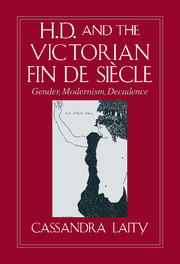Book contents
- Frontmatter
- Contents
- Acknowledgments
- Introduction: Dramatis Personae: The Aesthete Androgyne and the Femme Fatale
- 1 The Rhetoric of Anti-Romanticism: Gendered Genealogies of Male Modernism
- 2 H.D.'s Early Decadent Masks and Images: HER; Sea Garden
- The Aesthete Androgyne
- The Femme Fatale
- Postscript
- Notes
- Index
- CAMBRIDGE STUDIES IN AMERICAN LITERATURE AND CULTURE
1 - The Rhetoric of Anti-Romanticism: Gendered Genealogies of Male Modernism
Published online by Cambridge University Press: 06 January 2010
- Frontmatter
- Contents
- Acknowledgments
- Introduction: Dramatis Personae: The Aesthete Androgyne and the Femme Fatale
- 1 The Rhetoric of Anti-Romanticism: Gendered Genealogies of Male Modernism
- 2 H.D.'s Early Decadent Masks and Images: HER; Sea Garden
- The Aesthete Androgyne
- The Femme Fatale
- Postscript
- Notes
- Index
- CAMBRIDGE STUDIES IN AMERICAN LITERATURE AND CULTURE
Summary
Most recent critical commentaries on Eliot, Yeats, and Pound acknowledge their sometime conservative if not misogynist attitudes toward women. However, the complex of literary, historical, and psychosocial events underlying the hypermasculine rhetoric of the modernist poetic enterprise is just beginning to receive attention. Gail McDonald's pathbreaking Learning to Be Modem discusses at length Eliot's and Pound's project to “masculinize” the modern image of the poet and his work, although she subordinates the sex/gender issue to the (equally important) matter of class. Identifying the male modernists' compulsion to separate themselves from scribbling women and dandified men with the fall of the (American) “feminized” gentry and the emerging “culture of professionalism,” McDonald focuses on the ensuing class war that made it imperative for the male modern poet (and scholar) to remodel himself after “serious, hardworking, professional men who made substantive contributions to the real world.” “ ‘Women,’ ” McDonald notes, “was code for whatever stood in the way of serious, productive creation” (McDonald 62, 64, 87). In this chapter I suggest that Eliot's, Pound's, and Yeats's highly public “masculinization” of poetic modernism also constituted a response to the crisis of sex/gender identification that critics have attributed variously to Oscar Wilde's infamous trials, the proliferation of women writers, the New Woman, and other twentieth-century social or historical phenomena drawing attention to the epistemology of “sex.”
The mainstream poets' professed agenda for modernism appears to have shared the male modernist novelists' prohibition against sexual or androgynous female images such as the femme fatale – a taboo that Gilbert and Gubar attribute to the rise of the New Woman – and against the newly introduced type of “the homosexual” modeled after Oscar Wilde and his association with “leisure, privilege and high culture” in the aftermath of his trials.
- Type
- Chapter
- Information
- H. D. and the Victorian Fin de SiècleGender, Modernism, Decadence, pp. 1 - 28Publisher: Cambridge University PressPrint publication year: 1996



